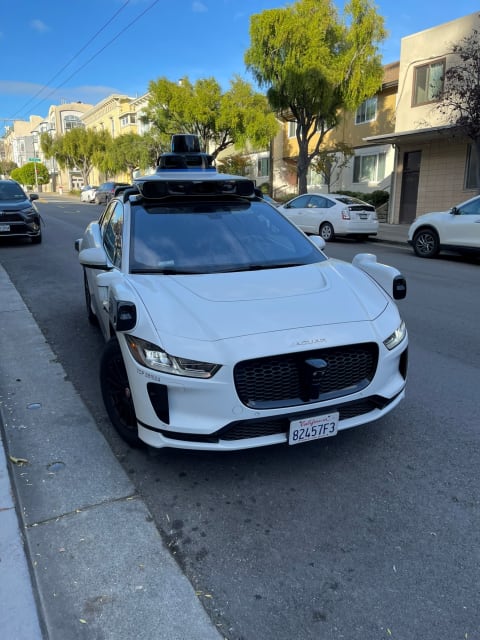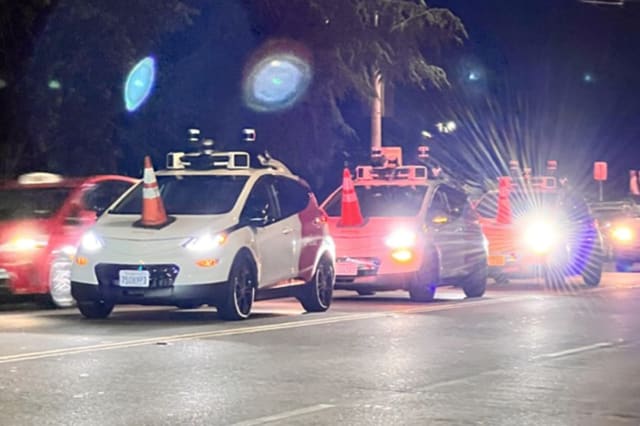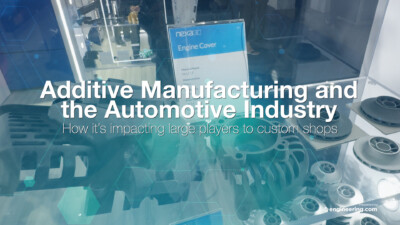Two editors endure a disappointingly mild Waymo robotaxi ride.

It was a cool but sunny Friday afternoon when Kenneth Wong, editor extraordinaire (Digital Engineering 24/7), and I waited for a Waymo robotaxi. It was going to be a first for both of us. Not living within San Francisco proper, Waymo’s limit of service, I had been denied the experience. But Kenneth, a San Francisco native for 20 years, had no excuse. We took our lunch at a Korean restaurant in Japantown, then hailed a robotaxi on the Waymo app.
Lovers of technology, keep reading. Those looking for thrills and adventure in traffic—that which the
media seems to delight in—robotaxis misbehaving, getting confused, running over and dragging pedestrians, as did a Cruise robotaxi
the evening of
October 2… will be disappointed.
In anticipation of our ride, I imagined troublesome scenarios for which the city is famous: not being able to see over the vehicle’s hood cresting some of San Francisco’s hills or getting caught in the intersection when a traffic light turned red. Zoom out to see gridlock. Zoom in to see angry pedestrians pounding on your hood and giving you the finger. They’ll do that in the city. Then there are the Munis, city buses that seem to operate with a God-given right of way that would plow into a confused robotaxi going the wrong way on a one-way street.
But on this Friday afternoon ride, nothing of that sort was happening. Both the ride to a cross-town BART station and the ride back to Japantown were equally uneventful.

robotaxi operating in rush hour San Francisco traffic was flawless.
I was filming the ride … and getting bored. Nothing was happening. Nobody was going to watch this.
Kenneth, who if not a Zen Buddhist should be one, put me back on track. Go to a theme park for a thrill ride, but “this is exactly how I’d want my Lyft driver to drive,” he corrected.
“Lyft rider? More like your grandma,” I replied, failing to appreciate the peace and quiet. In 4 miles of rush hour downtown traffic, the Waymo vehicle had not even braked hard or swerved. Had I had a cup of tea, not a drop would have spilled onto the saucer1 An oblivious driver opening a door ahead of us was met with an evasive move so gentle that only Kenneth noticed it. No drivers
in other vehicles honked. In fact, we attracted no attention from anyone outside the vehicle whatsoever. A stretch limo would have gotten us more attention than this Jaguar SUV bristling with more technology than the Russian embassy—its spinning LiDAR, cameras, radar … all failing to turn heads.
We had no driver for God’s sake. Surely, that is worthy of a second take? Yet no one was jumping in our path to test
the AV, no moms throwing their babies to safety. I see a passenger in another vehicle pulling up next to us with a camera up… but they are watching something on it and paying no attention to the second biggest San Francisco tech story of the year (the first is ChatGPT, silly). All this brilliant technology we were riding in—or deadly danger, depending on where you sit on the issue—was being ignored.
Relax. Enjoy the Ride
You call for a Waymo with the Waymo app, just as you would an Uber or Lyft. Waymo uses Jaguar I-PACE SUVs—always white. Ours arrived in 5 minutes
at a pickup spot in Japantown. Unlike Uber and Lyft rides, which come to you, you
have to hunt down a Waymo. Waymo chooses to, or is mandated to, use certain locations near where you are getting picked up. It does the same thing when dropping you off near where you want to go. That could be a little annoying. What if it was raining? What if you were used to door-to-door service and now you have to walk a couple of blocks at each end?
City dwellers get spoiled. Not Kenneth, of course.
The vehicle that waited for us around the corner was 18 inches from the curb, perhaps to show it was waiting and not parked? It was the only Waymo around, so it was easy to spot, but Waymo also puts your name in lights (just your initials, actually) on top of the car so you don’t have to check the license plate. The door handles popped out of the Jaguar as it sensed my approach.
Getting into the Waymo could be a little disconcerting if you are used to greeting your driver. I imagine my wife woul greet the car anyway. She’s not an engineer. The Waymo vehicle, perhaps programmed for this, issues a welcome greeting. You press “start” on a screen inside the car or on your app and you’re off.
The Waymo glides into traffic. Except for half a block where it seemed to straddle lanes, it stayed perfectly centered and allowed plenty of room from the car in front of it and from crosswalks at traffic lights. You got the sense that it was well programmed for all that it encountered. At one point, I wondered why it was stopped at a green light, but then realized it was because
it was waiting for space to open in the lane past the intersection. I might have driven out and been trapped in the intersection, but Waymo knew better than to do that.
We’ll skip to the end because nothing happened. The car tells you that you have arrived at your destination. You have to pull the door handle twice to get out. This may be challenging for the rich and inebriated, perhaps Waymo’s target customer, but it was no problem for two respectable editors. The Waymo is smart enough to tell you to watch out for cars if you are stepping out in traffic. You exit wordlessly. This will take some getting used to: no one to say hello or goodbye to, no one to tip.
How Much?
After being used to paying for personal service and door-to-door service, it was strange to have to pay about the same for the impersonal service of a Waymo. Our two rides were a little over $16.
“That’s about what Lyft would charge, said my ever-charitable city-dwelling friend.
But Kenneth, there is no driver! Shouldn’t I have to pay less? A lot less?
“Waymo is charging for the novelty,” offers my uncynical friend.
But what of the other ride San Francisco made famous, Kenneth? Cable cars don’t gouge their passengers or charge for the novelty. Honestly, does Alphabet (Waymo’s parent company, which also owns Google) really need an extra 10 bucks? Shouldn’t they be more interested in gaining public trust even if it means buying acceptance? Changing a city’s favored mode of travel is a long-term play. Waymos could be the new mobility. Play it right and Waymo, you have changed the conversation, changed what AV stands for, from annoying vehicles back to autonomous vehicles.
There Will Be Blood
One or two boring rides cannot serve as a guarantee of 100 percent safety for the future. Waymos work in traffic, around jaywalkers, cyclists, impaired drivers and other hazards. There will be situations for which they are not programmed. There will be blood. Like prime numbers, accidents will get less frequent with the increased presence of robotaxis, but there will always be another.
It is impossible to make something foolproof because fools are so ingenious. So it is with autonomous vehicles trying their best to dodge the fools they face in a limitless number of potentially dangerous situations. City officials and public agencies will be sure to require millions of miles of testing before they will allow robotaxis to operate without humans at the wheel. It’s for our safety, of course. Unspoken is the concern of taxi drivers—the most at risk of losing their livelihoods. Uber and Lyft drivers? They can switch to delivering restaurant food and groceries.

Waymo’s journey with robotaxis has not been without incident. A Waymo struck and killed a “small dog” in May 2023 according to the California DMV, which demands an accident report for every significant incident involving an autonomous vehicle. The dog death was downplayed by Waymo as unavoidable The San Francisco Chronicle assembled stats for all autonomous vehicle collisions reported, and as you can see in the above map, there have been plenty involving Waymo vehicles.
But a closer look at the accident reports on the DMV will reveal that few of the incidents were Waymo’s
fault. The dog’s death was the only fatality on record. No person has yet to be seriously injured by a Waymo. A Waymo struck a motorcycle after the motorcycle rider lost control of it. The Waymo slammed on the brakes but hit the riderless motorcycle. In another incident, an SUV cut in front of a Waymo so fast that the Waymo could not stop in time. In fact, in most of the incidents, it was either a pedestrian or a driver of another vehicle that was at fault.
“Within the first 1 million public road miles that we drove without a human behind the wheel, we had no reported injuries, no collisions with pedestrians or cyclists, and every vehicle-to-vehicle collision involved poor driving by a human,” says Mauricio Peña, Waymo’s Chief Safety Officer, in a July 6 post on the Waymo website.
Cruise Drummed Out of San Francisco
That Waymo has a chief safety officer is in and of itself a statement. Cruise, the other robotaxi company allowed to operate in San Francisco, only added a chief safety officer after one of its vehicles struck a pedestrian the night of October 2 and dragged them 20 feet before coming to a stop. Cruise tried to hide the recording of the incident, alleges the California Public Utilities Commission, and faces fines of up to $1.5 million. Cruise’s driverless operations were suspended. Although the company could still have operated Cruise with safety drivers, on October 24, GM shut down all of
its robotaxi operations in the U.S.

Anti-tech activists took great delight in placing the traffic cones on
Cruise cars, which left the vehicles confused and paralyzed. Source: Courtesy Safe Street Rebel.
It is possible that the city associated with tech gave little room for error to an
interloper from Detroit (Cruise is owned by GM). But it can also be said that Cruise’s
management was too cavalier about safety, too dismissive of complaints, too bent
on a mission to save us from ourselves.
On August 14, two stalled Cruise robotaxis delayed an ambulance taking an injured pedestrian to the hospital. The pedestrian died from their injuries. In an August 7 safety meeting, the San Francisco Fire Department told of 55 incidents in which autonomous vehicles had come too close to first responders. That several incidents involved Cruise vehicles should come as no surprise. Cruise has fewer miles driven in traffic than Waymo. By 2020, Waymo had completed 20 million miles of testing its AV fleet with “safety officers” at the wheel, whereas Cruise, just getting started, had 2 million miles
of testing.
It can be said that Waymo is a software company that also makes cars and Cruise is a car company that also writes software. Waymo’s Google ancestry has paid off enormously for Waymo. Waymo has been able to program many more situations and responses for its vehicles and can detect more shapes and predict more vehicle, pedestrian and cyclist behavior. Should Waymo use machine learning to model the behaviour of good drivers, it can probably draw on petabytes of traffic data from Google Maps and millions of hours of video from Street View plus Google’s leading-edge AI.
Data Points to Greater Safety
Although Waymo was involved in more incidents than Cruise, Cruise incidents resulted in more injuries, reports the San Francisco Standard. An exhaustive study by Ars Technica stated that “Cruise might have a problem with intersections,” whereas “Waymo has been successful at avoiding crashes at intersections” and concluded that “Cruise’s technology is pretty good but Waymo’s is better.”
Both tech editors involved in this admittedly unscientific experiment were thoroughly impressed with the way Waymo had solved some very difficult problems in negotiating dense city traffic and were convinced that Waymo was safer than being driven by a human driver. Ars Technica is a little more cautious, estimating Waymo to be about twice as safe as human drivers. By its calculations, humans driving the same number of miles as robotaxis in San Francisco would have had twice as many serious crashes.
The National Highway Traffic Safety Board estimates that there are around 6 million car crashes reported to the police each year.” The agency counted 42,795 human deaths from motor vehicle traffic crashes in the U.S. in 2022. That all by itself should scream to have human drivers replaced with well-tested, relatively safe robotaxis.
1. Legend has it that royal chauffeurs are hired after passing a teacup test. The tester in the back seat (that’s where the king or queen would sit), drinks a cup of tea and if one drop of tea falls from cup to the saucer, it’s game over.



